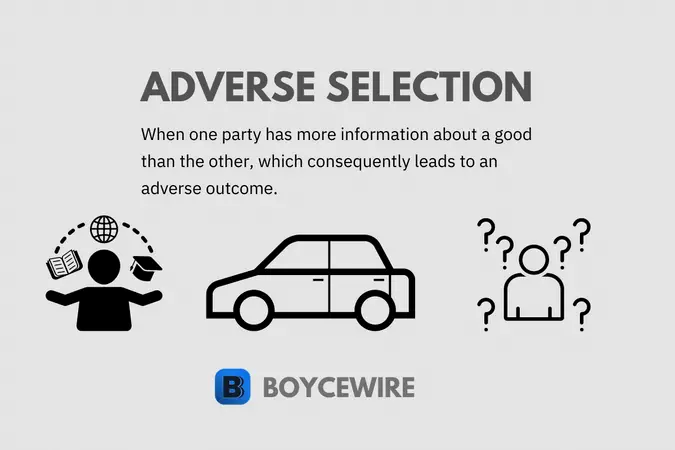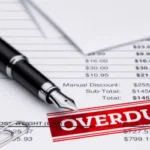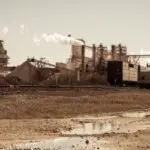Adverse Selection: (Definition & 4 Examples)

What is Adverse Selection
Adverse selection occurs when either the buyer or seller has more information about the product or service than the other. In other words, the buyer or seller knows that the products value is lower than its worth.
For example, a car salesman knows that he has a faulty car, which is worth $1,000. However, the customer has no idea about these faults. As far as they’re concerned, it’s in working condition, so are willing to pay $2,000. The transaction takes place, but the customer is then left with a faulty car worth half what they actually paid for it – resulting in adverse selection.
Key Points
- Adverse selection occurs when one party has more information on the good than the other.
- As one party has more information than the other, they are able to charge a higher price than if the other party had the same information. This leads to adverse selection.
Adverse Selection Examples
Adverse selection is where the seller or buyer has more information than the other party. For example, a used car salesman has more information on the working condition of the car than the buyer. Other examples include:
- Adverse Selection in Banking
- Adverse Selection in Used Cars
- Adverse Selection in Insurance
- Adverse Selection in Financial Markets
Adverse Selection in Banking
In banking, the consumer will have superior information than the bank. Whether it’s a small loan, a mortgage, or a business loan. The consumer will know their spending habits better than the bank. Equally, a business owner will know more about the industry and its future growth – although this may also be overly optimistic.
There is also the issue of trading between banks. For example, the 2008 financial crisis was in part driven by the packaging on ‘toxic loans’ which included sub-prime mortgages. These were packaged up with ‘safe’ debt and traded between banks. The original firms that packaged up these instruments knew how risky they were, but led to adverse selection as the purchasing party did not have the same information.
Adverse Selection in Used Cars
The used car example of adverse selection originated from ‘The Market for Lemons’ paper by economist George Akerlof. The idea was that the seller has either a quality product, a ‘peach’, or a faulty product, a ‘lemon’. In turn, the consumer has a fixed price by which that they can afford to purchase a car, which is in between the cost of a ‘peach’ and a ‘lemon. So they don’t have enough to buy a ‘peach’, but do for a ‘lemon’.
From the seller’s perspective, they know whether they hold a peach or a lemon. So they will try to sell the lemon over the peach.

From a second-hand car perspective, used cars differ in quality, so the worst ones get sold first. As a result, consumer expectations fall alongside the expected prices. So consumers expect low quality and cheaper goods.
However, at the same time, the sellers of ‘peaches’, or high quality second hand cars are pushed out of the market, leaving only ‘lemons’ behind.
Adverse Selection in Insurance
Whether it is health, life, or gadget insurance, those consumers who know that they have a higher risk are more likely to take out insurance. For example, the average person in their 20s is going to need less medical attention than someone in their 80s. However, most insurance companies will be able to determine risk based on age so can charge higher premiums on this basis.

With regards to adverse selection, there is also the issue of lifestyle choices. For example, a heavy smoker is more likely to take out life insurance as they know they pose a greater risk. There is no way the insurance company would know about this apart from a physical examination. Yet this adds on an additional cost which each consumer will have to pay in order to avoid adverse selection.
Adverse Selection in Financial Markets
When a business looks to go public with its shares, it has more information on the true value of the company. For example, the directors and decision makers work at the company every day. They know how the company is performing and whether it is functioning efficiently, so they have a greater level of knowledge of the company than the average investor.

What we can see as a result is that when companies float on the market, they are often largely overvalued due to the gap in information. For example, Twitter was sold at 41.65 USD on the NYSE back in 2013. Yet its value at the beginning of 2020 was just over 31 USD.
As those who float on the market have a greater idea on its true value, it is often sold at a higher rate than its true worth, leaving investors with ‘lemons’. Or in this case, over-priced shares.
Effects of Adverse Selection
Adverse selection occurs when there is a difference in information between the buyer and seller. This can increase costs, lower consumption, exclude customers, and potential increase the health risk. Examples of the effects of adverse selection include:
1. Higher Prices for Customers
As customers may not know of any faults or issues, the value they place on a good is much higher. For instance, a second-hand laptop may suggest that it is in fully working order. However, it may have water damage and is no longer functioning. The price a customer would pay between a working laptop and a faulty one is the additional price paid due to adverse selection.

Now companies such as eBay look to rectify such by requiring sellers to disclose such information. As such, they are also liable, with eBay acting as the intermediary between the two. So if a seller does sell a faulty item, the customer is able to obtain a full refund assuming the issue was not disclosed.
We also have higher prices in other markets such as insurance. Customers end up paying more as insurance companies are unable to fully determine risk. For instance, gadget insurance is more useful to those who are more clumsy than those who are not. Yet it is impossible to gather such information. So they have to charge all customers an equally higher amount.
So whilst clumsy customers will make more claims and cost the insurance firm more, they tend to increase prices across the board to cover these expenses. In turn, the ‘non-clumsy’ customers end up paying more to cover those who are more accident-prone.
2. Lower Consumption
As customers pay a higher price, it goes without saying that consumption will also fall. If we take insurance for example, some customers have to subsidise those who are more at risk.

As a result, they are having to also pay for the risk that other customers are imposing onto the insurance firm. In fact, some of these customers may withdraw from the market and not purchase insurance at all.
We also have the case whereby customers become more aware of issues with faulty goods and the discrepancies in knowledge. For instance, second hand markets are generally associated with unreliable goods. Perhaps after a couple of bad purchases, consumers tend to associate the bad feelings of being ‘ripped-off’, with the relevant market they purchased the good from.
What we see as a result, is lower consumption, at least in markets with asymmetrical information.
3. Health Risk
As customers do not always have full information on a good, it may potentially be harmful to them. For example, a faulty second hand car may pose a health and safety risk to the consumer. Faulty breaks or electrics could contribute to a significant accident.

Elsewhere, food is now often labeled across many developed nations, with nutritional values placed on them.
This is so factors such as caloric and sugar content are more visible to the consumer. We can see this as a more consumer friendly option as they are still freely allowed to choose, but with more information provided to them.
4. Excluded Customers
As adverse selection leads to higher costs, it equally means fewer customers are able and willing to afford goods. For instance, as insurance premiums increase to compensate for the lack of information, fewer customers will purchase insurance.
As a result, governments often step in to enforce a universal insurance scheme. By doing so, it forces those who are healthy to subsidise the costs for those who are sick.
Furthermore, this can be extended to other markets. For instance, second hand markets generally offer cheaper goods, which attracts more price sensitive customers. However, because the customer may not have much information on the product, they may not be confident in its value; particularly if they have had bad experiences with second hand products before.
Moral Hazard vs Adverse Selection
A moral hazard is whereby a third party bears the cost of another party’s action. The classic example used is that of insurance. For instance, when an individual is insured, they may be more reckless. So rather than taking their laptop to the toilet, they may leave in unguarded in the knowledge that it can be replaced if stolen.

By contrast, adverse selection is where there is a gap in information between the buyer and seller of a good. A common example of such is in the second-hand market whereby the seller may know that the product is not fully functional.
We can look at a moral hazard as an effect that occurs AFTER a transaction has taken place. So a consumer becomes more reckless after they are insured. There is then an information misalignment in the fact that the insurer is unaware of the additional risks taken by the consumer.
This is in contrast to adverse selection, whereby it occurs BEFORE the transaction takes place. So there is a misalignment of information between the buyer and seller before the trade is made.
Adverse Selection FAQs
Adverse selection is where one party in a transaction has more information about the good than the other. They are then able to use this superior information to extract a more favorable price out of the other party.
Adverse selection is a problem because it creates an inefficient allocation of resources. The customer pays more than the good is worth, whether by their own valuation or by the seller’s valuation. What this means is the customer is overpaying for the good and the seller is benefiting. This also creates a moral problem in the fact that sellers are actively encouraged to hide information that would devalue the goods they try to sell.
One of the classic examples of adverse selection is that of second-hand cars. The seller has more information on the car such as mileage and accident history. Such information may not necessarily be disclosed to the customer, so they may not be able to may an informed decision. Therefore their purchasing selection is adverse.
There are a number of solutions to adverse selection but differ depending on the industry. For example, health insurance firms may look to undertake a physical examination before insuring the customer. By doing so, they are able to identify any health issues and habits the individual may have. For instance, breathing problems may be a sign the customer is a heavy smoker. The insurance firm can then price their insurance more appropriately based on the risk.
Both are similar in the fact that one party benefits at the expense of another. However, adverse selection is where one party has more information that the other. In turn this can lead to moral hazard. This is because when one person has more information than the other, they may tend to take more risks as the third party, usually an insurance firm, will bear the costs.
About Paul
Paul Boyce is an economics editor with over 10 years experience in the industry. Currently working as a consultant within the financial services sector, Paul is the CEO and chief editor of BoyceWire. He has written publications for FEE, the Mises Institute, and many others.

Related Topics
Further Reading
 Finance Charge - A finance charge is the fee or interest imposed by a lender on a borrower for the use of credit…
Finance Charge - A finance charge is the fee or interest imposed by a lender on a borrower for the use of credit…  The Consequences of the Industrial Revolution - The consequences of the industrial revolution were far-reaching and included technological innovation, urbanization, labor exploitation, environmental degradation, social changes, and…
The Consequences of the Industrial Revolution - The consequences of the industrial revolution were far-reaching and included technological innovation, urbanization, labor exploitation, environmental degradation, social changes, and…  Law of Diminishing Marginal Returns: Definition & Examples - Diminishing Marginal Returns occur when increasing production further results in lower levels of output.
Law of Diminishing Marginal Returns: Definition & Examples - Diminishing Marginal Returns occur when increasing production further results in lower levels of output. 
